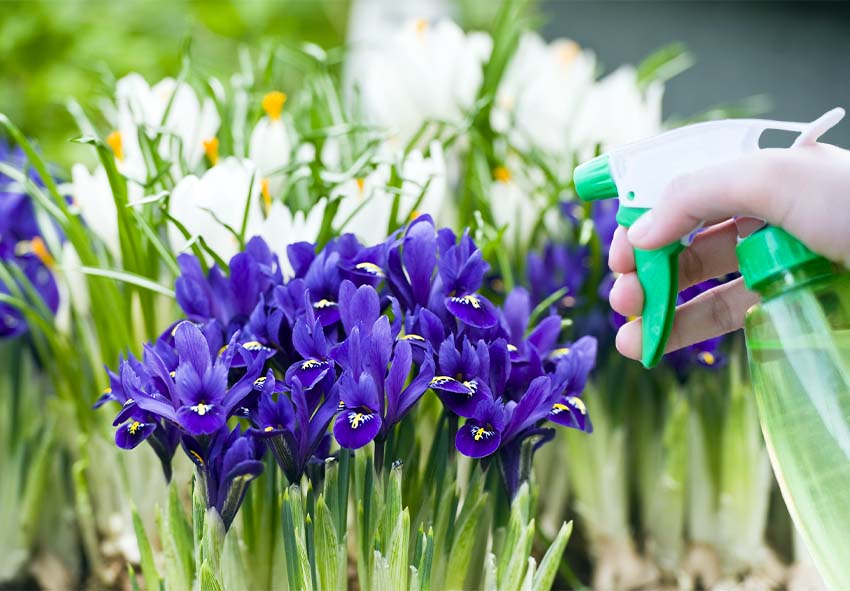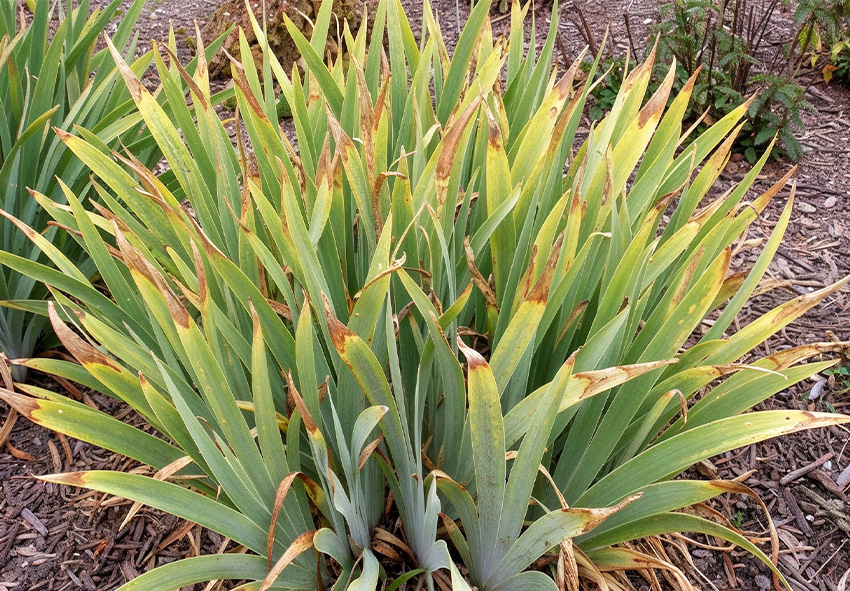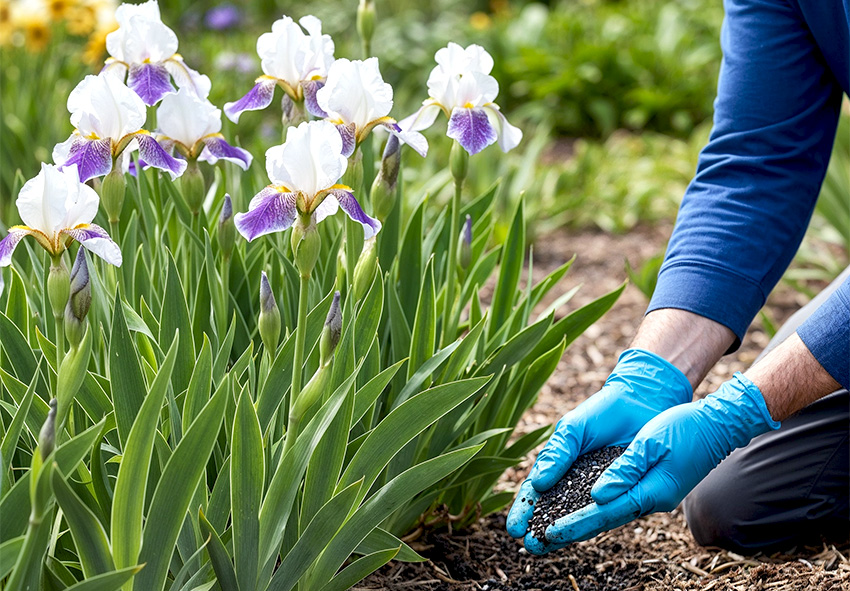Irises are among the most beautiful and versatile garden plants, but they are susceptible to a variety of diseases that can affect both foliage and rhizomes. Effective iris disease control is essential to keep your plants healthy, vibrant, and blooming year after year. By recognizing symptoms early and following proper care practices, you can prevent major infestations and ensure strong growth. Our gardening blog is a perfect place to find all the information you need!
Introduction to Iris Diseases

Iris diseases can spread quickly if left untreated, reducing flower quality and even killing the plant. Many infections thrive in wet or poorly drained conditions, so prevention is just as important as treatment. Understanding the types of iris diseases and their causes is the first step toward maintaining a thriving garden.
Why disease control is essential for irises
Diseases weaken plants, reduce bloom production, and can spread to other garden species. Controlling iris diseases not only protects individual plants but also safeguards the health of the entire garden bed. Regular monitoring and preventive care significantly improve long-term plant vitality.
Common environmental factors that encourage diseases
Irises are hardy plants, but their health can be compromised if growing conditions favor disease development. Fungal, bacterial, and viral problems often thrive in certain environments, especially when moisture and airflow are not well balanced. By recognizing these risk factors, gardeners can adjust their care practices to reduce infections:
- Excessive moisture – Standing water or overwatering creates conditions ideal for fungal growth and bacterial soft rot.
- Poor drainage – Heavy or compacted soils trap water around rhizomes, increasing the risk of rot.
- High humidity – Damp air encourages leaf spot and blight, especially in crowded beds.
- Overcrowding – Plants spaced too closely lack airflow, allowing diseases to spread quickly.
- Temperature fluctuations – Sudden changes between warm and cool conditions can stress irises, making them more vulnerable.
- Debris buildup – Old foliage left in beds provides shelter for overwintering spores and pests.
Overview of prevention and treatment methods
Effective iris disease control combines prevention, early detection, and targeted treatment. Practices include proper planting, cleaning up debris, using resistant varieties, and applying fungicides or organic treatments when necessary. Consistent care ensures irises remain healthy season after season.
Common Iris Diseases
Several diseases commonly affect irises, each with distinct symptoms and treatment approaches. Knowing which disease you’re dealing with allows for faster and more effective intervention.
Iris leaf spot (fungal disease)
Caused by Didymellina macrospora, leaf spot appears as small brown or black lesions on the leaves. Infected leaves may yellow and die prematurely. Removing affected leaves and applying fungicides can help prevent spread.
Bacterial soft rot in irises
This bacterial disease causes rhizomes to become soft, mushy, and foul-smelling. It often occurs in poorly drained soils or after mechanical damage. Immediate removal of infected rhizomes is critical to prevent contamination of healthy plants.
Botrytis blight and other fungal infections
Botrytis blight causes gray mold on leaves and flowers, especially in cool, wet conditions. Other fungal diseases include rust and crown rot, which also affect foliage and rhizomes. Maintaining good airflow and reducing leaf wetness are key preventive measures.
Viral diseases affecting irises
Iris mosaic virus and other viral infections can cause streaking or mottling of leaves and reduced flowering. There is no cure for viral diseases, so affected plants should be removed and destroyed to protect surrounding irises.
Identifying Symptoms of Iris Diseases

Early detection is critical for successful iris disease control. Knowing the signs of infection can prevent small problems from becoming major infestations.
Signs of fungal infections
Fungal diseases are among the most common problems affecting irises. They typically develop in damp or poorly ventilated conditions and can spread rapidly if not addressed. Recognizing the early signs of fungal infections helps gardeners take quick action before plants become severely damaged. Key symptoms of fungal infections include:
- Leaf spots – Small brown or black spots that enlarge and merge, often with yellow halos around them.
- Blighted foliage – Leaves may wilt, collapse, or die back prematurely during the growing season.
- Powdery or fuzzy mold – A gray or white fungal coating on leaves, buds, or flowers.
- Discolored or streaked leaves – Irregular markings that weaken foliage and reduce photosynthesis.
- Stunted growth – Infected plants may produce fewer flowers and appear weak compared to healthy irises.
Recognizing bacterial issues
Bacterial infections typically soften rhizomes and produce a foul odor. Foliage may wilt suddenly even with adequate water. Quick removal of affected tissue is essential to prevent the bacteria from spreading.
Differentiating between viral and environmental damage
Viral infections produce patterned discoloration and stunted growth. Environmental issues, like frost or nutrient deficiency, may cause similar leaf damage but do not spread. Accurate diagnosis ensures the correct control measures are used.
Preventive Measures for Healthy Irises
Preventing diseases is often easier and more effective than treating them. Healthy cultural practices reduce stress on plants and make them less susceptible to infection.
Proper soil preparation and drainage
Plant irises in well-draining soil to prevent rhizome rot. Raised beds or amended soil with organic matter improves drainage and promotes healthy roots. Good soil preparation reduces the likelihood of bacterial and fungal infections.
Spacing and air circulation in iris beds
Space plants adequately to allow airflow between leaves. Avoid overcrowding, which traps moisture and promotes fungal growth. Proper spacing also makes it easier to inspect plants for early signs of disease.
Seasonal cleaning and sanitation practices
Remove dead foliage and spent flowers regularly to prevent disease buildup. Sterilize tools after working with infected plants. Clean garden beds at the end of the season to reduce overwintering spores.
Treatment Options for Iris Diseases
Even with prevention, some iris diseases may require active treatment. Choosing the right method depends on the type of infection and severity.
Natural and organic control methods
Neem oil, baking soda sprays, and copper-based fungicides can control fungal infections. Beneficial microbes in the soil may suppress pathogens naturally. These methods are safe for the environment and reduce chemical use in your garden.
Chemical treatments and fungicides
For severe fungal problems, commercial fungicides can be applied according to label instructions. Always follow safety guidelines and avoid overuse to prevent resistance. Fungicides are most effective when applied early.
Removing and destroying infected plants
Infected plants should be removed immediately to prevent spread. Dispose of diseased rhizomes and leaves far from healthy iris beds. Do not compost infected material, as this can harbor pathogens for the next season.
Long-term Care Strategies

Maintaining healthy irises year-round supports disease resistance. That’s why it is essential to know how to care for irises in your garden. Combining good cultural practices with monitoring ensures long-term garden success. Here are some care strategies for you:
- Crop rotation and planting resistant varieties: Rotate iris planting locations every few years to reduce soil-borne disease buildup. Choose disease-resistant iris cultivars when possible to minimize infection risk.
- Fertilization and balanced watering techniques: Provide adequate nutrients to strengthen plant defenses, but avoid over-fertilizing, which can encourage soft growth susceptible to disease. Water at the base of plants to keep foliage dry.
- Monitoring and routine inspections: Regularly inspect leaves, rhizomes, and flowers for early signs of disease. Prompt action prevents minor issues from becoming serious outbreaks. Keep records to track recurring problems and adjust care practices accordingly.
Final Thoughts on Iris Disease Control
Iris disease control is a combination of prevention, early detection, and proper treatment. Healthy cultural practices, good sanitation, and monitoring are essential to maintain vibrant irises year after year. By taking proactive steps, gardeners can enjoy strong, beautiful blooms and minimize losses to diseases!
Frequently Asked Questions (FAQs) about Iris Disease Control
1. What are the most common diseases affecting irises?
Irises are prone to several diseases, including iris leaf spot, bacterial soft rot, and fungal blight. These conditions are usually triggered by excess moisture, poor air circulation, or contaminated soil. Recognizing symptoms early and adjusting care practices can significantly reduce the spread of these problems and keep plants healthy.
2. How can I prevent fungal diseases in my iris plants?
To prevent fungal issues, plant irises in well-drained soil, avoid overhead watering, and space plants adequately for airflow. Removing dead foliage in fall and applying a fungicide when necessary also helps reduce fungal spores. Healthy planting conditions are the best defense against recurring infections.
3. Can I order Dutch Irises from your online store?
Yes, you can! Our online store Dutch-bulbs.com offers a wide selection of Dutch Irises, including different varieties and colors. We take pride in providing top-quality plants that are carefully cultivated and shipped with care to ensure they reach you in perfect condition.
4. Are there natural methods to protect irises from pests and diseases?
Yes, gardeners can use organic solutions like neem oil or insecticidal soap to deter pests that weaken plants and make them disease-prone. Compost and balanced fertilization also strengthen irises naturally. Regularly inspecting plants and maintaining clean garden beds go a long way in preventing problems without chemicals.
5. When should I apply fungicide to irises?
Fungicide should be applied preventively in early spring as new growth emerges, especially in regions with wet climates. Reapply during the growing season if rainy weather persists or signs of infection appear. Always follow label directions and combine chemical treatment with good cultural practices for best results.
Published: 10.10.2025
